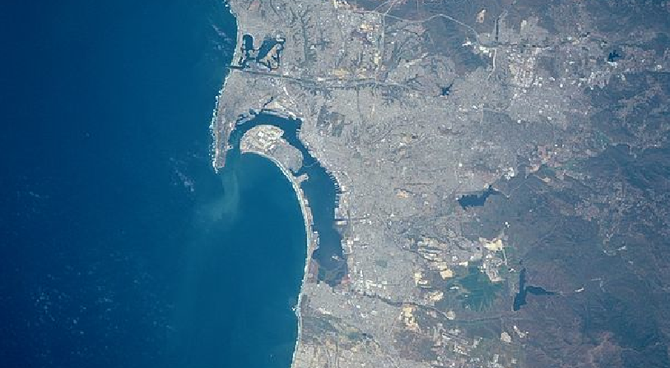 Facebook
Facebook
 X
X
 Instagram
Instagram
 TikTok
TikTok
 Youtube
Youtube

At their monthly meeting on May 7, members of the Oceanside Senior Anglers fishing club received an update on the Navy’s effort to increase recreational fishing and protect coastal resources.
Mitch Perdue, senior biologist from the Navy’s Facilities Engineering Command (NAVFAC) spoke about the increased fish populations now found in military-controlled areas of San Diego Bay, Camp Pendleton, and San Clemente Island.
Several decades ago, San Diego Bay was considered an industrially polluted waterway, from which most would not eat fish caught in it. Since 1989, the Navy has monitored water conditions and worked with environmental agencies to clean up the bay’s water.
Perdue, who grew up in Escondido, said he learned to fish in local waters. He said 17 species have returned to the bay, including lobster, Calico bass, spotted bass, surfperch, and a pod of seven male sea turtles that now call the bay home (female turtles only visit from South America or Mexico.) Navy boat operators are advised by NAVFAC of the sensitive areas where the sea turtles live, in order to avoid disturbing habitat.
The Navy participates with other organizations to check toxicity levels of fish caught from around the area. When asked by a club member if Perdue would now eat fish out of the once polluted bay, he answered with an enthusiastic, “Yes.”
Perdue said special-interest groups sometimes want to “blame the big gray ships” for environmental damage to fisheries, but his organization now has scientific data to indicate the contrary. Fish counts are up. Perdue stated that when his department presents the data, “science shortens the conversation.”
NAVFAC is also in the recycling arena, responsible for dropping off clean concrete destined for the Miramar landfill into the ocean off the Silver Strand. While the exact locations of the two “fish condos” are secret, within two weeks, said Perdue, the underwater structures began to attract kelp spores, and soon younger fish and lobster flourished.
Some environmental groups want the Navy to pull up miles of buried, ocean floor cables that were used in the World War II-era for communications and ship-movement detection. Perdue said NAVFAC found that advanced eco-systems have attached themselves to the cables. Their removal would disturb natural habitats and set back the area eco-systems five years.
“We have the data to prove leaving the cables in place is a good idea,” Purdue said. “Nothing is leaking or being emitted from the cables.” Regardless, the issue is being examined in Washington, D.C., according to Perdue.


At their monthly meeting on May 7, members of the Oceanside Senior Anglers fishing club received an update on the Navy’s effort to increase recreational fishing and protect coastal resources.
Mitch Perdue, senior biologist from the Navy’s Facilities Engineering Command (NAVFAC) spoke about the increased fish populations now found in military-controlled areas of San Diego Bay, Camp Pendleton, and San Clemente Island.
Several decades ago, San Diego Bay was considered an industrially polluted waterway, from which most would not eat fish caught in it. Since 1989, the Navy has monitored water conditions and worked with environmental agencies to clean up the bay’s water.
Perdue, who grew up in Escondido, said he learned to fish in local waters. He said 17 species have returned to the bay, including lobster, Calico bass, spotted bass, surfperch, and a pod of seven male sea turtles that now call the bay home (female turtles only visit from South America or Mexico.) Navy boat operators are advised by NAVFAC of the sensitive areas where the sea turtles live, in order to avoid disturbing habitat.
The Navy participates with other organizations to check toxicity levels of fish caught from around the area. When asked by a club member if Perdue would now eat fish out of the once polluted bay, he answered with an enthusiastic, “Yes.”
Perdue said special-interest groups sometimes want to “blame the big gray ships” for environmental damage to fisheries, but his organization now has scientific data to indicate the contrary. Fish counts are up. Perdue stated that when his department presents the data, “science shortens the conversation.”
NAVFAC is also in the recycling arena, responsible for dropping off clean concrete destined for the Miramar landfill into the ocean off the Silver Strand. While the exact locations of the two “fish condos” are secret, within two weeks, said Perdue, the underwater structures began to attract kelp spores, and soon younger fish and lobster flourished.
Some environmental groups want the Navy to pull up miles of buried, ocean floor cables that were used in the World War II-era for communications and ship-movement detection. Perdue said NAVFAC found that advanced eco-systems have attached themselves to the cables. Their removal would disturb natural habitats and set back the area eco-systems five years.
“We have the data to prove leaving the cables in place is a good idea,” Purdue said. “Nothing is leaking or being emitted from the cables.” Regardless, the issue is being examined in Washington, D.C., according to Perdue.
Comments